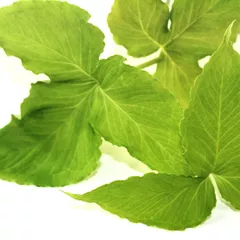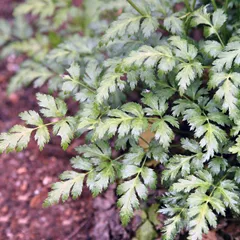Phlegm-Fluids in the Stomach and Small intestine
The information provided here is not a replacement for a doctor. You shouldn't use it for the purpose of self-diagnosing or self-medicating but rather so you can have a more informed discussion with a professional TCM practitioner.
At a glance
Preliminary reading: What is a pattern? The concept of Phlegm The concept of Fluids The Stomach in Chinese Medicine The Large Intestine in Chinese Medicine The Small Intestine in Chinese Medicine
Key attributes
Chinese name: 痰饮 Pinyin name: Tán Yǐn
Pattern nature: Full
Pattern hierarchy: Specific pattern under Phlegm-Fluids
Causes
Precursor patterns: Spleen Yang Deficiency
Diagnosis
Common symptoms: Dry tongue Weight loss Loose stools Chest fullness Vomiting of watery fluids and three other symptoms
Pulse type(s): Deep (Chen), Slippery (Hua), Wiry (Xian)
Tongue description: Swollen tongue with white slippery or yellow sticky coating
Treatment
Treatment principle: Warm the Spleen Yang and Qi, remove Phlegm-Fluids, dispel Dampness, drain water through urination.
Common formulas: Xiao Chai Hu Tang Ban Xia Xie Xin Tang Xuan Fu Dai Zhe Tang and one other formulas
Pathology
Phlegm-Fluids is a type of Substantial Phlegm characterized by white, very watery and thin sputum. It can sometimes actually be heard splashing in the body.
Phlegm-Fluids in Stomach and Intestines simply refers to a pattern whereby Phlegm-Fluids accumulates in those Organs. It often does so when the transportive and transformative functions of the Middle-Burner are damaged due to Spleen Yang Deficiency.
Please be aware that the term 'Phlegm-Fluids' has its general or specific meaning. The general one refers to all Phlegm-Fluids patterns including the following 4 main ones:
- Phlegm-Fluids in the Stomach and Small intestine (Tan Yin, 痰饮)
- Phlegm-Fluids in the hypochondrium (Xuan Yin, 悬饮)
- Phlegm-Fluids in the limbs (Yi Yin, 溢饮)
- Phlegm-Fluids above the diaphragm (Zhi Yin, 支饮)
The specific meaning refers to only the pattern of Phlegm-Fluids in the Stomach and Small intestine (Tan Yin, 痰饮).
Causes
Precursor patterns: Phlegm-Fluids in the Stomach and Small intestine can derive from Spleen Yang Deficiency
Diagnosing Phlegm-Fluids in the Stomach and Small intestine
Diagnosing a pattern in Chinese Medicine is no easy feat and should be left to professional practitioners. In particular one has to know how to differentiate between different types of pulses and tongue coatings, shapes and colors as well as learn to read from a long list of seemingly unrelated symptoms.
Pulse type(s): Deep (Chen), slippery (Hua) or wiry (Xian)
Tongue description: Swollen tongue with white slippery or yellow sticky coating
Main symptoms: Dry tongue Weight loss Loose stools Chest fullness Vomiting of watery fluids Splashing sound in the stomach Abdominal distention and fullness Dry mouth with no desire to drink
Diagnosis commentary: Key characteristic symptoms of this pattern are the chest distension and fullness as well as the water splashing sound of the Stomach.
Treating Phlegm-Fluids in the Stomach and Small intestine
Treatment principle
Warm the Spleen Yang and Qi, remove Phlegm-Fluids, dispel Dampness, drain water through urination.
Herbal formulas used to treat Phlegm-Fluids in the Stomach and Small intestine



The top herbs in Ling Gui Zhu Gan Tang are Poria-Cocos Mushrooms (Fu Ling), Cinnamon Twigs (Gui Zhi) and Atractylodes Rhizomes (Bai Zhu)
Ling Gui Zhu Gan Tang
Source date: 220 AD
Number of ingredients: 4 herbs
Key actions: Warms and transforms Phlegm-Fluids. Strengthens the Spleen. Resolves Dampness.
Formula summary
Ling Gui Zhu Gan Tang is a 4-ingredient Chinese Medicine formula. Invented in 220 AD, it belongs to the category of formulas that warm and transform water and Dampness.
Besides Phlegm-Fluids in the Stomach and Small intestine, Ling Gui Zhu Gan Tang is also used to treat Cold-Phlegm in the Lungs or Phlegm-Fluids.



The top herbs in Xiao Chai Hu Tang are Bupleurum Roots (Chai Hu), Baikal Skullcap Roots (Huang Qin) and Crow-Dipper Rhizomes (Ban Xia)
Xiao Chai Hu Tang
Source date: 220 AD
Number of ingredients: 7 herbs
Key actions: Treats the Lesser Yang Channels (Gallbladder and Triple Warmer). Regulates the Liver and Spleen functions. Addresses combined Yin-Yang symptoms of External and Internal, Excess and Deficiency, and Hot and Cold.
Formula summary
Xiao Chai Hu Tang is a 7-ingredient Chinese Medicine formula. Invented in 220 AD, it belongs to the category of formulas that harmonize lesser Yang-warp disorders.
Besides Phlegm-Fluids in the Stomach and Small intestine, Xiao Chai Hu Tang is also used to treat Lesser Yang stage or Half Exterior Half Interior.



The top herbs in Xuan Fu Dai Zhe Tang are Inula Flowers (Xuan Fu Hua), Hematite (Dai Zhe Shi) and Crow-Dipper Rhizomes (Ban Xia)
Xuan Fu Dai Zhe Tang
Source date: 220 AD
Number of ingredients: 7 herbs
Key actions: Regulates the downward flow of Stomach Qi. Expectorant, treats hiccups.
Formula summary
Xuan Fu Dai Zhe Tang is a 7-ingredient Chinese Medicine formula. Invented in 220 AD, it belongs to the category of formulas for a rebellious Qi.
Besides Phlegm-Fluids in the Stomach and Small intestine, Xuan Fu Dai Zhe Tang is also used to treat Rebellious Qi or Rebellious Liver Qi invading the Stomach.



The top herbs in Ban Xia Xie Xin Tang are Goldthread Rhizomes (Huang Lian), Baikal Skullcap Roots (Huang Qin) and Crow-Dipper Rhizomes (Ban Xia)
Ban Xia Xie Xin Tang
Source date: 220 AD
Number of ingredients: 7 herbs
Key actions: Reverses the flow of Rebellious Stomach Qi. Relieves both Heat and Cold Stagnation in the gastrointestinal tract.
Formula summary
Ban Xia Xie Xin Tang is a 7-ingredient Chinese Medicine formula. Invented in 220 AD, it belongs to the category of formulas that harmonize Stomach-Intestines.
Besides Phlegm-Fluids in the Stomach and Small intestine, Ban Xia Xie Xin Tang is also used to treat Phlegm-Heat in the Middle Burner.
